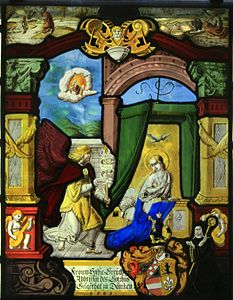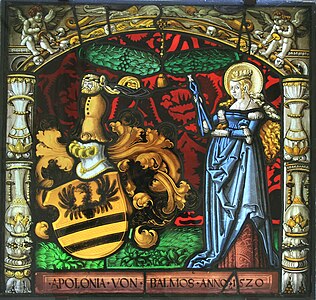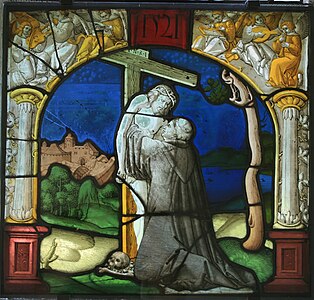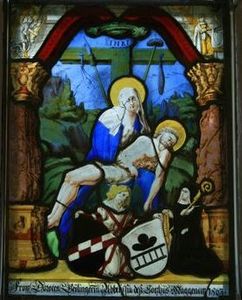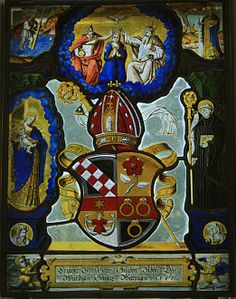Coats of arms of the Wettingen monastery
The heraldic disks of the Wettingen monastery are located in the cloister of the monastery and are the only regionally independent Swiss disks . This means that they were given to the monastery and never left it. Other monasteries have mostly lost their rich glass jewelry in the iconoclasm or after their dissolution in the course of secularization . Many museums - also outside of Central Europe - nowadays adorn themselves with such works of art.
history
With the exception of a few older panes of glass in the tracery of some windows that survived the monastery fire of 1507, all are of later date. The tracery discs left over from the old picture decorations are probably from a much larger series, as one can expect in this wealthy Cistercian monastery. The cloister will be fitted out with new window panes according to a plan. 135 window axes were available for the pictorial program carried out in the time of the abbots Johann Müller and Andreas Wengi (1486–1528), which were to be equipped from the northeast corner of the cloister - at the monk's entrance to the church. For the group of Thirteen Old Places, which had existed since 1513, 26 of a total of 30 window axes for 13 pairs of panes were planned for the east wing . It can no longer be determined today whether a foundation of the city of Baden joined this, as was the case in the conference hall in Baden .
The group of works comprises a total of 137 coats of arms and figure disks. The oldest, located in the north arm, date from around 1280/1290 and are among the earliest preserved stained glass in Switzerland . On the coats of arms, which were given to the monastery by friendly monasteries, the 13 old towns of the Confederation , neighboring cities and the kings of France and Spain , there are images of saints legends, battles, coats of arms and the names of the donors.
The windows were last restored in 2006 for a total of 1,900,000 francs.
Compared to the supraregional outstanding, early Gothic monumental glass paintings of the monastery church in Königsfelden from the first half of the 14th century, the 200 years younger, small-format glass paintings of the monasteries of Muri and Wettingen are somewhat behind, but because of their nationwide uniqueness they also deserve a high artistic and art-historical significance. “Both cloisters are still 'showcases' of federal self-expression” by their donors.
North arm
In the north arm of the cloister, 47 panes can be found below the early Gothic stained glass. There are four panes on each of eleven tracery window arches and three on one window arch. Many of the discs placed here seem to have been used here from the start. For the most part, it is window donations from bailiffs, secular priests and Wettinger Franciscan Minorites .
East arm
32 coats of arms can be found in the east arm. They were donated by cities in the area such as Baden , Mellingen and Bremgarten and the estates of the Swiss Confederation .
South arm
At the beginning, i.e. in the period before the Reformation , these windows may have remained empty as a reserve. But it is also possible that the extreme hailstorm of August 8, 1576, to which the west-facing windows were exposed, destroyed older works that could have survived the Reformation period unscathed. Around 1579 there was a major rearrangement of the window group.
In the south arm of the cloister there are 26 panes in thirteen arches. They were created in the years 1623/1624 and show a narrative cycle of Mary. The panes were created by the Zug glass painter Christoph Brandenberg. The abbot of Wettingen Monastery at the time, Peter Schmid, had campaigned for the monastery to receive such disks as a gift. As was customary at the time, the donors did not give the disk, but a sum of money, whereupon the abbot selected the artist and commissioned the work. However, the cycle of Mary is missing four pictures that were stolen in an unexplained way in the 19th century. They reappeared in 1923 at an auction by the Comtess of Craven . When these panes were restored in a Zurich workshop in 1928, the Swiss National Museum succeeded in documenting these panes. Then they were lost again.
During the renovation in 2001, it was decided to include photo prints of these panes in the cycle. It is not clear where the originals are today. From right to left the cycle begins with a disc that was donated by an abbot Bernhardus and shows his coat of arms.
West arm
In the west arm there are fourteen window arches and four in the northernmost window arch, for a total of 32 panes. They are predominantly double foundations of friendly monasteries: the double panes from Salem, Kappel and St. Urban as well as the single panes from Frienisberg , Hauterive, Lützel, Neuburg, Bebenhausen, Herrenalb and Tennenbach have been preserved.
gallery
Benedict with abbot's staff and poison glass with Fintan with stick, book and dove (1560)
Bishop Ulrich and Augustine (around 1560)
Bernhard of Clairvaux with Christ (1521)
Stand disk from Basel, around 1520 by Hans Holbein the Younger
The St. Martin sharing his cloak.
Loreto scene. Founder Jakob Linder (1588) kneeling at the bottom left
embroidered coat of arms with Citeaux, Rapperswil, Wettingen Monastery, Abbot Christoph Silberysen (1566)
Pietà scene. Coat of arms of Cîteaux, Wettingen Monastery, Petrus Eichhorn. Founder Abbot Petrus Eichhorn kneeling on the right (1550)
Web links
Individual evidence
- ↑ a b c d Bernhard Anderes, Peter Hoegger: The glass paintings in the Wettingen monastery . Baden-Verlag 1988, ISBN 3-85545-031-5
- ↑ http://www.tagesschau.sf.tv/Nachrichten/Archiv/2006/09/13/Kultur/Wappenscheiben-im-Kloster-Wettingen-restauriert Tagesschau reports on the renovation of the windows


